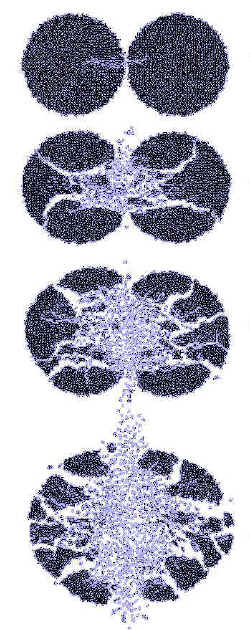The Shattering Effects of a Collision

From the largest asteroid to the tiniest nucleus, everything breaks if it is hit hard enough. A paper in the March issue of Physical Review E describes computer simulations of two flat, brittle disks bumping into each other at a wide range of energies. These simulations show that there are two distinct ways in which the disks break up–below a critical energy they splinter into large chunks, and above it they shatter into thousands of small fragments. This insight into how things break could be useful to industries that extract ores by blasting rocks apart and to space researchers coping with the problem of man-made debris colliding with Earth-orbiting satellites.
Researchers in the past have smashed both real and virtual objects together to learn how they break. The size of the broken fragments is always distributed according to a power law–the number of fragments is proportional to the inverse of the fragment size raised to a power–independent of the type of material or its original size. However, no one has carefully looked at more gentle collisions, when the objects do not hit hard enough to completely shatter. So Ferenc Kun and Hans Herrmann of the University of Stuttgart in Germany created a computer program to explore these low impact collisions.
They built up disks of about 40 cm in diameter from many randomly shaped polygons about 1 cm in size. Each polygon was unbreakable and represented thousands of atoms of a solid material. Elastic interactions between the polygons were represented by “beams” that could flex, bend or break. During the simulated collision of the disks, the computer continuously calculated the stress on each beam, breaking polygons away from their neighbors when the stress was too great. The program then counted the number and size of the pieces of the disk that remained after impact.
Below a certain impact energy, the disks showed signs of damage–they broke into a few large chunks. Above that critical impact energy, however, they shattered into many small pieces. The team found that the power law behavior of the fragment sizes held for impacts at and above the critical energy, which depended only on the binding energy of the material. They also proved that the crossover from the damaged state to the fragmented state was a second-order phase transition.
Didier Sornette, of the University of California in Los Angeles, is leading a study of the effects of debris on space vessels, and he believes that the work offers a deeper understanding of the fragmentation process. “The work can also be used as a starting point for very high energy simulations,” he says, “where there might be other regimes of behavior and critical points.” Sornette is interested in extremely high energy collisions because much of the space junk travels at many kilometers per second.
–Meher Antia
Meher Antia is a freelance science writer.


